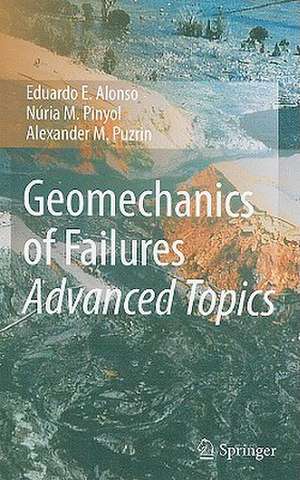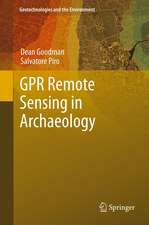Geomechanics of Failures. Advanced Topics
Autor Eduardo E. Alonso, Núria M. Pinyol, Alexander M. Puzrinen Limba Engleză Hardback – 17 aug 2010
This unconventional approach to geomechanics is the essence of this book. In general, soil mechanics and geotechnical textbooks describe first the concepts and theoretical developments and then apply them to interpret or solve a particular applications. This book follows a different course. The case (a failure) is first described and then an explanation is sought. This requires a set of steps which can be summarized as follows: Identify the nature of the problem, develop a dedicated and specific formulation of the case, based on established basic concepts. In general, no single existing theory or procedure is available to solve the case at hand, provide a solution within an acceptable degree of complexity, extract the fundamental aspects of the problem and highlight its relevance.
The cases selected have been grouped into three main topics: Landslides, Embankments and Dams and Dynamics of Failures. Cases selected (Vaiont, Aznalcóllar, Brattas-St. Moritz) are unique and illustrate a number of relevant and to some extent controversial issues which are of wide interest, without claiming exhaustive treatment of the subject.
The book teaches how to build the necessary models to understand the failures. Well established soil mechanics concepts are the necessary background. But the cases analyzed require in general a step ahead which is specific for the case analyzed. Balance and equilibrium equations are often required as a starting point. They are formulated at different scales, which are selected having in mind the abstract representation of each case.
Various chapters illustrate also the coupled nature (flow-deformation-temperature) of geotechnical problems and the need to properly address these complexities in some cases. In fact, temperature effects, a subjectoften neglected in conventional analyses, are necessary to explain some catastrophic landslides (Vaiont). In some of the chapters, specific calculation tools, included in well known and widely available programs (Excel, Maple…) have been used. Details of the ad hoc programs developed have also been included in Appendices to help the readers to follow the details of the calculation.
Finite element methods have not been used. In the landslides analyzed (Vaiont and Brattas-St. Moritz) currently available commercial programs are of limited utility. In the remaining cases the analysis performed provides a sufficient insight and interpretation of field behaviour.
Chapters include also a short description of the changes in the original design and the mitigation measures which could have prevented the failure. Also, a summary section of lessons learned is provided in all chapters. Finally, selected topics and more advanced reading are suggested.
This book is associated with a Master/Doctorate course being offered at the Department of Geotechnical Engineering and Geosciences of UPC, Barcelona. Potential readers therefore include Graduate and Master students, faculty and professionals in the fields of Civil and Geotechnical Engineering.
| Toate formatele și edițiile | Preț | Express |
|---|---|---|
| Paperback (1) | 387.75 lei 6-8 săpt. | |
| SPRINGER NETHERLANDS – 13 dec 2014 | 387.75 lei 6-8 săpt. | |
| Hardback (1) | 475.47 lei 6-8 săpt. | |
| SPRINGER NETHERLANDS – 17 aug 2010 | 475.47 lei 6-8 săpt. |
Preț: 475.47 lei
Preț vechi: 559.38 lei
-15% Nou
Puncte Express: 713
Preț estimativ în valută:
91.01€ • 98.89$ • 76.50£
91.01€ • 98.89$ • 76.50£
Carte tipărită la comandă
Livrare economică 21 aprilie-05 mai
Preluare comenzi: 021 569.72.76
Specificații
ISBN-13: 9789048135370
ISBN-10: 9048135370
Pagini: 277
Ilustrații: VIII, 277 p.
Dimensiuni: 155 x 235 x 20 mm
Greutate: 0.54 kg
Ediția:2010
Editura: SPRINGER NETHERLANDS
Colecția Springer
Locul publicării:Dordrecht, Netherlands
ISBN-10: 9048135370
Pagini: 277
Ilustrații: VIII, 277 p.
Dimensiuni: 155 x 235 x 20 mm
Greutate: 0.54 kg
Ediția:2010
Editura: SPRINGER NETHERLANDS
Colecția Springer
Locul publicării:Dordrecht, Netherlands
Public țintă
Professional/practitionerCuprins
Landslides.- A Constrained Creeping Landslide: Brattas-St. Moritz Landslide, Switzerland.- Catastrophic Slide: Vaiont Landslide, Italy.- Embankments and Dams.- Collapse of Compacted Soil: Girona Road Embankments, Spain.- Earth Dam Sliding Failure: Aznalcóllar Dam, Spain.- Dynamics of Failures.- Thermo-Hydro-Mechanics of a Rapid Slide: Vaiont Landslide, Italy.- Dynamics of Dam Sliding: Aznalcóllar Dam, Spain.
Notă biografică
Eduardo E. Alonso, born in 1947, got his degree in Civil Engineeering (Ingeniero de Caminos, Canales y Puertos) in Madrid in June 1969. He got a PhD in Northwestern University in 1973. At present he is Professor of Geotechnical Engineering at the UPC in Barcelona. He is the author of more than 300 papers published in Proceedings of Conferences and learned journals. Professional activities include foundation problems, deep excavations, nuclear power plants, slope stability, breakwaters, earthdams, tunneling and underground waste disposal. Awards: Thomas Telford Medal (ICE) in 1994 and 2007; Crampton Prize (ICE) in 2006; J. Torán Prize in 1995; N. Monturiol medal in 2000; Second Coulomb lecturer in 2003 and Eleventh Buchanan Lecturer, Texas A&M in 2003; Tenth Sowers Lecturer, GeorgiaTech, Atlanta in 2005. He is member of the Royal Academy of Engineering of Spain since 1995 and member of the Royal Academy of Sciences and Art of Barcelona since 2007.
Núria M. Pinyol, born in 1978, got her degree in Civil Engineering (Ingeniero de Caminos, Canales y Puertos) in Barcelona in June 2004. At present she is a Researcher of the International Center for Numerical Methods in Engineering (CIMNE, Barcelona). She has worked on the development of constitutive models for bonded expansive soils and in the analysis and modeling of the geotechnical behaviour of earth and rockfill dams. One of her papers ("A review of Beliche dam") was awarded the Crampton Prize (ICE, UK) in 2006. Her main research interests are: behavior of unsaturated soils, expansive soils and rocks, hard soils and soft rocks, numerical analysis in Geomechanics, dams, slope stability and rapid slides.
Alexander M. Puzrin, born in 1965, studied Structural Engineering at Moscow Institute of Civil Engineers (1982-1987) and Applied Mathematics at Moscow State University (1990). He received his Ph.D. in Geotechnical Engineering from the Technion - Israel Instituteof Technology in 1997, where he joined the faculty. In 2002 he became a faculty at the Georgia Institute of Technology (USA). He has been Professor of Geotechnical Engineering at the ETH Zurich since 2004. Prof. Puzrin has been involved as an expert in geotechnical projects in Russia, Israel and Switzerland. His expertise lies in progressive and catastrophic failure and constitutive modeling of geomaterials. He is the author of more than 60 papers. Awards: Technion Excellence in Teaching Award in 2001; ASCE (Student Chapter) Outstanding Faculty Award in 2003; ICE Bishop Medal in 2004.
Núria M. Pinyol, born in 1978, got her degree in Civil Engineering (Ingeniero de Caminos, Canales y Puertos) in Barcelona in June 2004. At present she is a Researcher of the International Center for Numerical Methods in Engineering (CIMNE, Barcelona). She has worked on the development of constitutive models for bonded expansive soils and in the analysis and modeling of the geotechnical behaviour of earth and rockfill dams. One of her papers ("A review of Beliche dam") was awarded the Crampton Prize (ICE, UK) in 2006. Her main research interests are: behavior of unsaturated soils, expansive soils and rocks, hard soils and soft rocks, numerical analysis in Geomechanics, dams, slope stability and rapid slides.
Alexander M. Puzrin, born in 1965, studied Structural Engineering at Moscow Institute of Civil Engineers (1982-1987) and Applied Mathematics at Moscow State University (1990). He received his Ph.D. in Geotechnical Engineering from the Technion - Israel Instituteof Technology in 1997, where he joined the faculty. In 2002 he became a faculty at the Georgia Institute of Technology (USA). He has been Professor of Geotechnical Engineering at the ETH Zurich since 2004. Prof. Puzrin has been involved as an expert in geotechnical projects in Russia, Israel and Switzerland. His expertise lies in progressive and catastrophic failure and constitutive modeling of geomaterials. He is the author of more than 60 papers. Awards: Technion Excellence in Teaching Award in 2001; ASCE (Student Chapter) Outstanding Faculty Award in 2003; ICE Bishop Medal in 2004.
Textul de pe ultima copertă
The backbone of Geotechnical Engineering does not concern the development of more or less sophisticated tools and theories. It remains in a previous step. When facing a real problem it is necessary to isolate its fundamental aspects and to achieve a correct conceptual representation of its nature. This phase requires abstract thinking, which is certainly assisted by a proper understanding of paradigms and theories of Soil and Rock Mechanics. The process of abstract thinking with the aim of identifying the key issues usually renounces to complexity and secondary details. To be successful, concepts should be simple and rooted on well established mechanical and physical knowledge. Only when the relevant mechanisms or phenomena which define the problem are well understood, additional sophistication may be added for a more accurate analysis or interpretation. This book remains in this first "simple" stage.
The correct identification of the essential traits of a geotechnical situation relies heavily also on accumulated experience and on educated intuition. But, how to educate intuition and how to transfer practical experience?
Geotechnical failures, specially the catastrophic ones, are an excellent experience and a source of inspiration to improve our current understanding of phenomena and our procedures and tools for analysis and prediction. This unconventional manner to learn Geomechanics is the essence of this book which teaches how to build the necessary models to understand failures. Balance and equilibrium equations are formulated at different scales which are selected having in mind the abstract representation of the key concepts of each case.
The correct identification of the essential traits of a geotechnical situation relies heavily also on accumulated experience and on educated intuition. But, how to educate intuition and how to transfer practical experience?
Geotechnical failures, specially the catastrophic ones, are an excellent experience and a source of inspiration to improve our current understanding of phenomena and our procedures and tools for analysis and prediction. This unconventional manner to learn Geomechanics is the essence of this book which teaches how to build the necessary models to understand failures. Balance and equilibrium equations are formulated at different scales which are selected having in mind the abstract representation of the key concepts of each case.
Caracteristici
Ideal textbook combining well-known appealing cases with problems and solutions in a structural approach Includes supplementary material: sn.pub/extras
























